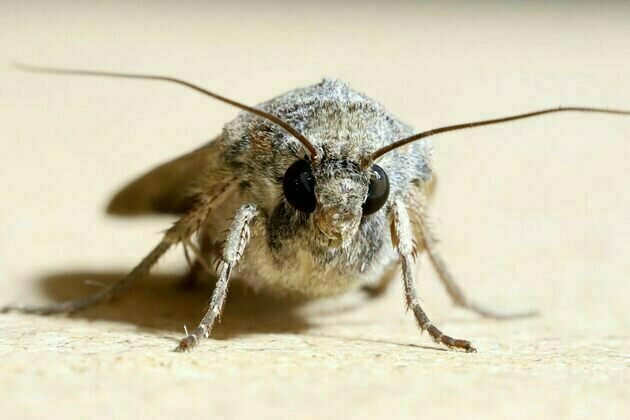Migrating bogong moths use the stars and Earth's magnetic field to find ancestral summer caves each year
The Conversation
19 Jun 2025, 00:02 GMT+10

It's a warm January summer afternoon, and as I traverse the flower-strewn western slopes of Australia's highest mountain, Mount Kosciuszko, I am on the lookout for a tell-tale river of boulders that winds its way down into the alpine valleys below.
Here, hidden in cave-like hollows and crevices formed deep within the river of boulders, is one of the most spectacular natural phenomena in the insect world - the summer mass gathering of an iconic Australian insect, the bogong moth (Agrotis infusa).
Tightly huddled together in their dim cool cavernous world, with each moth's head pushed slightly under the wings of the moth just ahead, millions of bogong moths sleep out the summer, slumbering in a state of dormancy known as "aestivation".
Their little bodies coat the stone surfaces in an endless soft brown carpet, with 17,000 of them tiling each square metre of cave wall. It's a sight that never fails to take my breath away.
To get here, these moths have flown from all over southeast Australia through the spring, arriving from as far away as south-eastern Queensland and far-western Victoria. Converted to human body length, these journeys of roughly 1,000 kilometres would be equivalent to a person circumnavigating Earth twice.
The moths' marathon voyages to the Alps are likely undertaken to escape the lethal heat of the coming summer in their breeding areas. When the cool of autumn arrives, the moths leave the mountains to produce their own offspring and die.
But how on Earth do they know how to find these caves? How do they know the direction to travel and how do they know when they've arrived?
These questions have fascinated me and the other members of my research group for many years. It turns out bogong moths possess a most extraordinary ability to navigate, harnessing Earth's magnetic field and the stars as compasses to follow their inherited migratory direction.
We made these remarkable discoveries in a specialised lab we built a few years ago near Adaminaby in the Snowy Mountains of New South Wales.
First we light-trapped bogong moths that were either migrating towards the Alps in spring or away again in autumn. We next placed them in a special flight arena inside the lab, and finely controlled Earth's magnetic field (with magnetic coils around the arena) and the starry night sky (by projecting a highly realistic starry night sky on the roof of the arena).
Because we already knew bogong moths have a magnetic sense, we used the coils to completely remove, or null, the magnetic field in the arena. This ensured any orientation using the stars was not confounded by the ability to detect Earth's magnetic field.
What we found next astounded us. Using only the local Australian starry night sky projected above them, bogong moths flying in our arena were able to discern and follow their inherited migratory direction - both in spring and in autumn.
If we turned this projected sky by 180, the moths turned and flew in exactly the opposite direction. If we then took all of the stars in this projected natural sky and randomly distributed them across the roof of the arena, the moths became completely confused and lost their ability to migrate in their inherited migratory direction.
In the absence of all other possible cues, bogong moths clearly used the stars as a true compass to discern a geographic direction relative to north.
This is the first invertebrate we so far know of that can do this. Only human beings and some species of night-migratory birds are known to have this ability.
But in moths this ability is even more remarkable considering their brain is approximately one-tenth the volume of a grain of rice and their eyes only a couple of millimetres wide.
We made a final discovery when we moved our flight arena up onto the hill behind the lab under the magnificent dome of the natural starry sky. As expected, the moths were beautifully oriented in their inherited migratory direction.
But on one of these nights the sky was heavily overcast with cloud. To our great surprise, the moths remained oriented in their migratory direction, even though the stars were obscured.
The only remaining cue that could have been used was Earth's magnetic field, which showed very clearly that moths rely on two compasses - a magnetic compass and a stellar compass.
But of course, two compasses will always be better than one - if one becomes corrupted or drops out, the other can take over. Nature's perfect solution for robust navigation!
Despite its fantastic abilities, this tiny navigator is under threat. A result of anthropogenic climate change, the recent drought in Australia saw bogong moth numbers fall by a jaw-dropping 99.5%.
Endangered alpine marsupials that depend on the moth's arrival in spring for food - such as the mountain pygmy possum - suffered heavily as a result.
Droughts in southeast Australia are only predicted to worsen in both frequency and intensity. The future of the bogong moth, as well as the fragile alpine ecosystem that depends on it, does not look very bright.
 Share
Share
 Tweet
Tweet
 Share
Share
 Flip
Flip
 Email
Email
Watch latest videos
Subscribe and Follow
Get a daily dose of Brisbane Star news through our daily email, its complimentary and keeps you fully up to date with world and business news as well.
News RELEASES
Publish news of your business, community or sports group, personnel appointments, major event and more by submitting a news release to Brisbane Star.
More InformationAustralia
SectionCanada seeking calm at G7, despite abrupt departure of Trump
BANFF, Alberta: The recent G7 summit has convened for the second and final day in the picturesque Canadian Rockies amidst escalating...
Migrating bogong moths use the stars and Earth's magnetic field to find ancestral summer caves each year
It's a warm January summer afternoon, and as I traverse the flower-strewn western slopes of Australia's highest mountain, Mount Kosciuszko,...
EU could cancel visa-free travel for Israelis Euronews
Brussels has introduced new rules that could place restrictions on countries found in violation of the UN charter or international...
ICC announces schedule for Women's T20 World Cup 2026; India to face Pakistan on June 14 at Edgbaston
Dubai [UAE], June 18 (ANI): The International Cricket Council unveiled the ICC Women's T20 World Cup 2026 schedule on Wednesday, which...
Kisik Lee replaces Baek Woong Ki as India's new recurve archery head coach
New Delhi [India], June 18 (ANI): Republic of Korea's Kisik Lee is set to be the new head coach of India's national recurve archery...
With solid body of work in red-ball game, can Jurel make it to playing XI during England tour?
London [UK], June 18 (ANI): As discussions around India's playing eleven for the first Test against England at Leeds continue, with...
International
Section'Tourists go home': Anti-over-tourism protests erupt in Barcelona
BARCELONA/MADRID, Spain: With another record-breaking tourist season underway, thousands of residents across southern Europe marched...
Flight recorder may reveal cause of deadly crash of Air India Boeing
NEW DELHI, India: The flight data recorder from the crashed Air India plane was found on June 13. This vital discovery may help investigators...
Severe storm strikes Dongfang in Southern China
BEIJING, China: A typhoon altered its course and struck Hainan Island, southern China, late on the night of June 13. Typhoon Wutip...
Canada seeking calm at G7, despite abrupt departure of Trump
BANFF, Alberta: The recent G7 summit has convened for the second and final day in the picturesque Canadian Rockies amidst escalating...
UNAIDS: Trump’s HIV aid cuts risk reversing global progress
JOHANNESBURG, South Africa: A key global plan to end AIDS as a public health threat by 2030 is now in deeper jeopardy after the United...
Trump leaves G7, calls for evacuation of Iran's capital
CALGARY, Alberta, Canada - U.S. President Donald Trump has announced he is leaving the G7 summit after just one day, and after refusing...











